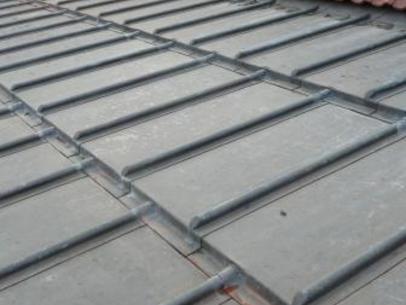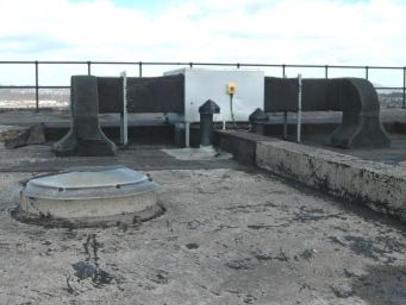Stone deteriorates through the action of moisture and frost. Stone naturally absorbs water and then dries – a process generally referred to as ‘breathing’. The use of cement mortar can prevent this breathing process, leading to damage. As our winters get wetter with climate change, it is important to take better care of stone walls.
External stone walls are usually about 600mm thick, made from a stone outer face and rougher infill stone or brick inside. Lime mortar bonds the materials together.
The internal finished plaster surfaces are fixed to the stone wall but have an air gap which allows water vapour to travel through the wall.
The walls at bays, oriels and corner turret windows are thinner than the main external walls and less able to hold moisture. Timbers set into these thinner walls are most vulnerable to decay from damp and rot.
Types of stone
Sandstone
Sandstone is the softest of building stones used in tenements. It ‘weathers’ (decays) easily. It is also porous, so it absorbs water easily and needs to be kept dry if possible and allowed to dry if it gets wet. It is relatively easy to carve and shape.
Sandstone has a distinct ‘bedding’ or alignment caused by the way the stone was formed in layers. The stone needs to be laid with the correct alignment of the bedding (generally a horizontal bedding).
 Blonde sandstone. Commonly found in tenements in the west of Scotland, the cream coloured stones darken with air pollution (cleaned sandstone on left). Image courtesy of Annie Flint.
Blonde sandstone. Commonly found in tenements in the west of Scotland, the cream coloured stones darken with air pollution (cleaned sandstone on left). Image courtesy of Annie Flint.
 Red and blonde sandstone. With the advent of railways, red sandstone started to succeed blonde sandstone as a building material. Image courtesy of Annie Flint.
Red and blonde sandstone. With the advent of railways, red sandstone started to succeed blonde sandstone as a building material. Image courtesy of Annie Flint.
 Grey sandstone. A buff grey sandstone was commonly used in Edinburgh, sourced from the Craigleith Quarry.
Grey sandstone. A buff grey sandstone was commonly used in Edinburgh, sourced from the Craigleith Quarry.
Granite
Granite is a durable, hard stone that is pale or silvery grey, though a pink granite was also used around Peterhead, Aberdeenshire. It does not weather as easily as sandstone and is less porous, so does not absorb water as easily. While this is an overall advantage, it does mean that rain will penetrate cracks and run directly into the building rather than being absorbed by the stone.
 Granite stone. Commonly used in the north-east of Scotland in and around Aberdeen.
Granite stone. Commonly used in the north-east of Scotland in and around Aberdeen.
Whinstone
Whinstone is the term used to describe a range of dark coloured, hard, dense rocks, such as basalt and dolerite. It is hard to shape, so is not normally used for detail. It is less porous than sandstone.
 Whinstone used with red sandstone detailing.
Whinstone used with red sandstone detailing.
Problems
Past repairs
‘Plastic repairs’ using cement mortar were often used to repair stone. Cement was also used to repoint stones. Most of these older cement repairs are now cracking and require to be replaced. The cement tends to be hard and impervious, allowing water to be trapped in the stone where it can then freeze and expand, damaging both the stone and the cement mortar.
 Failing ‘plastic’ repair.
Failing ‘plastic’ repair.
 Old ‘Linostone’ repair
Old ‘Linostone’ repair
Stone decay
This can be caused by:
- moisture coming from leaks in gutters, downpipes, flashings, rottten cills or failing mastic around windows which then saturates an area of stone
- moisture unable to escape from the structure due to the use of hard non-breathable cement and paint
- in chimneys, added exposure and the effects of chemicals from gas combustion and coal smoke
- incorrect bedding of stones or simply the natural process of weathering and ageing
Pointing
Cement mortar pointing does not allow stone to ‘breathe’, so it stays damp as moisture can only escape through the stone, rather than through the pointing and this damages the stone.
 Hard cement repairs causing damage to stone. Moisture unable to escape through cement pointing causes stone to flake and decay.
Hard cement repairs causing damage to stone. Moisture unable to escape through cement pointing causes stone to flake and decay.
Stone cleaning
Stone cleaning is not now normally undertaken as it can cause too much damage to the stone. To improve the appearance of your building, deal with causes of stains first (such as leaking downpipes).
If painted stonework is particularly unsightly or problematical, ask for the professional advice of a conservation architect or surveyor – they may decide that the DOFF hot wash system is suitable in your case.
More about paint and graffiti removal
Plant growth
Moss and plant growth can build up, especially on horizontal courses of stone such as string courses and cornices. Small windblown seeds can lodge in open joints in the stone, then root growth can cause severe damage. Protect projecting stone cornices and string courses with leadwork in some exposed locations.
Rusting cramps
Cramps are used to hold stones together. If they are not rustproof, these metal cramps, when exposed to wetting over long periods, will expand as they rust, breaking the stone.
 Rusting metal cramp (staple). As metal rusts, it expands. This breaks the stone.
Rusting metal cramp (staple). As metal rusts, it expands. This breaks the stone.
Other problems
Other problems you may encounter are:
- damp patches on inside walls where plaster touches damp stone
- cracks
- peeling paint and graffiti
- salt damage to stones next to treated roads
Solutions
Pointing
Get stone repointed with a lime mortar that matches the existing using the best match of sand or aggregate in colour and coarseness. Stronger and more durable lime mortar mixes are available for use in exposed situations, such as the pointing of chimneys.
In unlisted tenements, you can seek advice from a stone masonry firm to advise on what lime mortar would be a good match. Some lime mortar suppliers will try to help in this process, although they will simply be matching by a visual look and feel of the old pointing material.
More information about pointing
Stone decay
- get a professional survey carried out – proper surveys must be carried out from a cherry–picker, however, as these cannot reach the rear walls, a good contingency allowance is required in any stone repair contract for defects that cannot be seen or inspected at close hand
- remove old repairs that are failing
- it may be possible to get stone redressed
Indent repairs
Used where stone has weathered by more than 30 – 44mm, indenting is where a defective area of a stone is cut out and new matching stone inserted using stainless steel dowels. In some cases, this will be a partial indent, such as at the base of a stone mullion. In other cases, it may be a full stone replacement, such as at a lintel.
 New indented stone. New stone above, original stone below.
New indented stone. New stone above, original stone below.
 Indenting new stone. New indented stone is fixed into the backing stone with stainless steel rods and lime mortar.
Indenting new stone. New indented stone is fixed into the backing stone with stainless steel rods and lime mortar.
Matching stone
As the majority of original quarries are long closed, replacement stone needs to be brought in from elsewhere. New replacement stones should match the existing stones, not simply in colour but also in porosity and permeability. If a less porous stone than the original is used, it can effectively force moisture into adjacent stones causing further damage.
Both the British Geological Survey and the Scottish Lime Centre will analyse samples of existing stone and suggest suitable matches from currently active quarries.
Plastic repairs
These are repairs where a mortar material is used to repair damaged stonework.
Rather than use cement, best practice today would be to use natural hydraulic lime mortar for the repair as this allows stone to breathe better. Some companies provide special premixed lime based mortars which are colour matched to different stones.
Where the damaged area is deeper than 40mm or an edge is required, reinforcement should be used (wire fixed to stainless or brass screws).
Dressing back stone
Some less badly worn and flaking stone can be treated with a bristle brush or (unlisted buildings only) carefully dressed back with a hand chisel.
Cracked lintels
Cracked lintels are quite common, and although they can be repaired, complete replacement is a better long-term solution.
Stapling cracks
Some hairline cracks in stone can be repaired by inserting a stainless steel staple or cramp into holes on either side of the crack and recessing the staple.
 Stapling a crack.
Stapling a crack.
Treating rusted cramps or staples
Ideally remove and replace with stainless steel cramps. If not possible, treat the rusted cramp before repairing.
Protecting string courses and cornices
Protect these horizontal courses of stone with a lead flashing. Ideally, the flashing should be shaped to fall away from the building, so rain splashes bounce away from the building.
Professional help required?
Where large areas of stone require repair, seek professional help to diagnose the cause of the problem and specify repairs. For smaller areas of disrepair, use a specialist firm with experience in this type of work.
Who pays?
Stonework repairs are normally a common responsibility.
Further information




